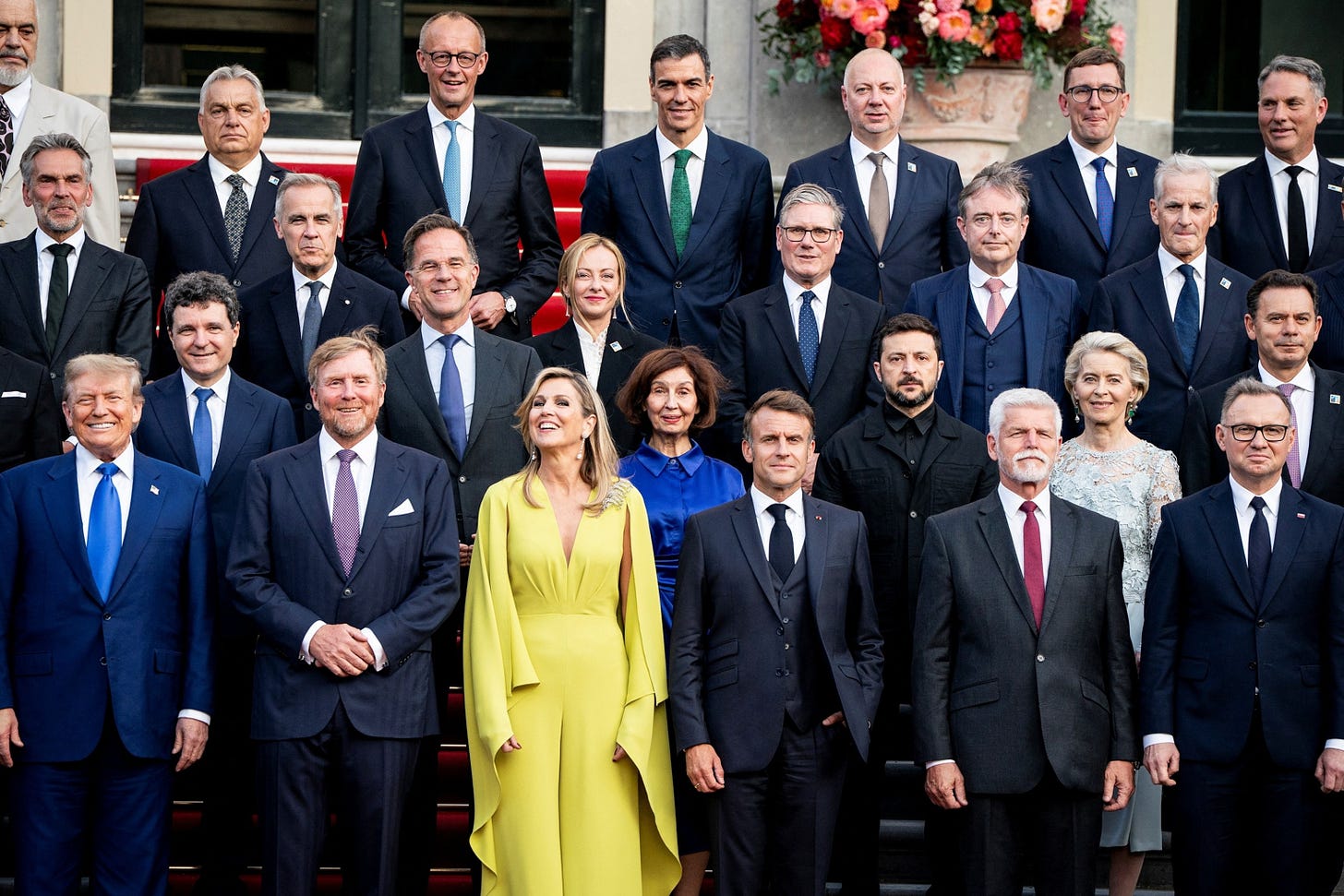A Victory on NATO Defense
Europe Boosts its Spending
The 2025 NATO Summit
The latest NATO summit has set in motion what could be the most significant redefinition of the transatlantic alliance since the end of the Cold War. Against a backdrop of mounting security threats, NATO leaders agreed to raise their collective defense spending target to 5% of GDP by 2035, a leap few would have predicted even a year ago.
The summit emphasized shoring up Europe’s defenses. Russia’s invasion of Ukraine is now in its fourth year, and while Ukrainian resilience and Western support have stymied Moscow’s ambitions, the costs have climbed steadily. Europe has also become more hawkish.
German chancellor Friedrich Merz endorsed recent U.S. strikes on Iranian targets. NATO Secretary General Mark Rutte declared that Europe and the United States stand united. And Donald Trump, who once called NATO obsolete and threatened to abandon it, appeared almost triumphant as he praised allies for finally stepping up. Europe is no longer assuming that American protection is unconditional.
Impact on the United States
For the United States, this is a long-awaited outcome of decades of unsuccessful pressure. Every president since Eisenhower has complained, publicly or privately, about European defense free-riding. That frustration only intensified as NATO expanded and new threats emerged.
True burden-sharing is now closer to a reality. As European nations rearm, the U.S. will have greater freedom to reallocate military assets and political capital to the Indo-Pacific, where the rise of China represents Washington’s most consequential long-term challenge.
Yet this achievement carries significant tradeoffs. American leverage over European security decisions has rested on dependence: U.S. troops, U.S. weapons, and U.S. guarantees. As Europe grows more self-reliant, it will also grow more independent.
A future in which European governments chart their own course on sanctions against Russia, negotiations over Ukraine’s status, or policies toward Iran and China is no longer theoretical. Divergence is coming, and Washington will have less power to prevent it.
A Bit of NATO History
To understand how remarkable this moment is, it helps to look back at history. NATO was born out of the wreckage of World War II, designed to anchor American leadership in Europe and prevent another catastrophic war while deterring an expansionist Soviet Union. During the Cold War, the U.S. was the indispensable guarantor of European security, underwriting defense budgets and deploying hundreds of thousands of troops across the continent.
Even after the Soviet collapse, NATO remained the primary mechanism for American influence in Europe. While enlargement brought in new members, it also deepened the reliance on U.S. capabilities. For decades, Washington pressed European capitals to spend more and plan seriously for their own defense, with limited success.
The Pivot Around Ukraine
That inertia finally cracked in 2022 when Russia launched its full-scale invasion of Ukraine. Suddenly, the stakes were no longer abstract. President Biden led a strong diplomatic and military response, coordinating unprecedented sanctions and supplying Kyiv with the weapons that blunted Russia’s advance. Over time, the effort degraded Russian capabilities to the point that Europe could realistically provide for its own defense.
Still, the war has taken its toll. What began as a rallying point for Western unity has evolved into a grinding stalemate. Ukrainian forces have held the line but remain outgunned and exhausted. European publics are weary of the costs, and in Washington, congressional support has frayed.
Though walkbacked by the president, the Pentagon’s recent suspension of munitions deliveries has injected new uncertainty into Ukraine’s prospects, . Despite these challenges, the war has exposed Russian military weakness and reinforced the need for Europe to prepare for future contingencies without assuming the U.S. will be there.
A Shifting Global Landscape
Nowhere is this shift clearer than in Eastern Europe. Poland, the Baltic states, and Finland have moved swiftly to rearm and host expanded U.S. deployments. Their sense of existential threat has produced a remarkable transformation in defense policy.
They have even withdrawn from a treaty banning anti-personnel mines as they prepare to fortify their borders with Russia. In France, President Macron has revived discussions about expanding the French nuclear umbrella as a European deterrent. Germany has pledged unprecedented increases in defense spending and modernization, and is now the world’s fourth largest defense spender.
These changes are not happening in isolation. They are intimately linked to the broader U.S. pivot to Asia. For years, American policymakers have warned that sustaining deterrence against China would require difficult choices about force allocation. The Quad, an informal partnership of the U.S., Japan, India, and Australia, has become a centerpiece of this effort. A stronger European pillar within NATO creates space for Washington to deepen Indo-Pacific cooperation without leaving Europe dangerously exposed.
Looking Ahead
NATO could evolve into a more European-led alliance, with the U.S. assuming the role of an offshore balancer, still committed, but less central. Alternatively, divergence over strategy toward Russia, Iran, and China could erode the coherence of the alliance.
A second Trump term could accelerate burden-sharing but also deepen mistrust, especially if threats to withdraw U.S. support reemerge as diplomatic leverage. The essential question is whether Europe is simply spending more or genuinely preparing to act independently if American priorities shift elsewhere.
Europe’s new spending commitments mark a turning point decades in the making. The Biden administration’s rallying of NATO after Russia’s invasion created the conditions for this transition, while Trump’s percieved unpredictability forced European leaders to rethink their assumptions.
The United States has gained flexibility to focus on China, but at the price of diminished control over Europe’s strategic decisions. Whether this tradeoff ultimately strengthens or weakens American interests will depend on how well Washington manages a more capable, and more autonomous, Europe.



